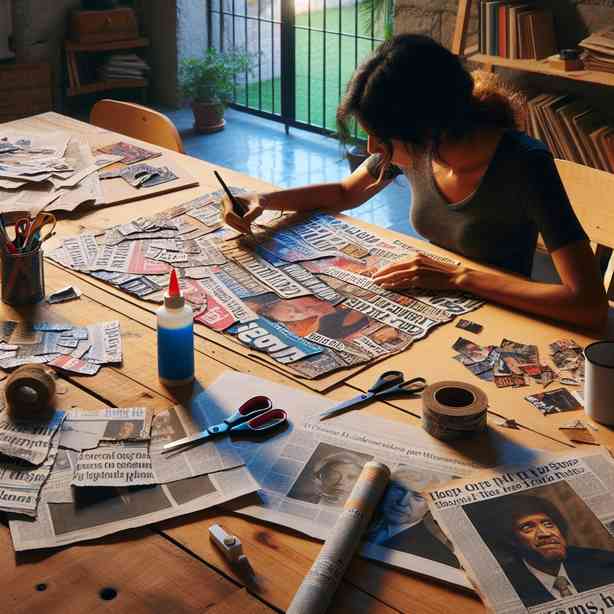
Collaging newspaper headlines has become an intriguing form of artistic expression and social commentary, primarily for its ability to distill significant events and cultural phenomena into digestible visual narratives. The journey of creating such collages is often sparked by a confluence of personal interest, historical context, and the sheer impact of news in our daily lives. By exploring this expressive medium, I discovered not only a method for creative output but also a way to engage deeply with the world around me.
My initial foray into collaging stemmed from a growing fascination with the media’s role in shaping public perception. As I observed the news cycle, I recognized how various headlines could encapsulate complex issues into succinct statements. Each headline represented more than just the facts; it was a window into societal attitudes, fears, and aspirations. The art of collaging allowed me to scrutinize these narratives, combining them to create a fuller picture of the world we inhabit.
The creative process of collaging involves selecting headlines that resonate with particular themes or emotions. For instance, focusing on environmental issues might lead me to collect articles about climate change, natural disasters, and public response. Furthermore, by juxtaposing these headlines, I could highlight contradictions or instigate conversations about the topics that often go unnoticed. In this way, the act of collaging transforms passive consumption of news into an interactive dialogue.
When I first started this artistic endeavor, I found inspiration in the chaos and complexity of contemporary life. There was something profoundly liberating in taking bits of information and reassembling them into something new, something that might speak to others in a way that the original headlines did not. Each collage became a personal reflection of my thoughts and feelings, a canvas where I could process the noise of daily news broadcasts and social media updates.
One of the most rewarding aspects of collaging newspaper headlines is the community it fosters. Sharing my work with others invited conversations that delved deeper into the subjects represented. It opened doors to discussions about representation, bias in media, and the ways in which certain stories are elevated over others. This dialogue not only enriched my understanding of various issues but also connected me with individuals who shared similar passions and concerns.
Moreover, collaging serves as a form of activism. In a time when misinformation runs rampant, creating collages that highlight factual headlines allows me to reinforce important messages and encourage others to think critically about the sources of their information. Through visual engagement, I strive to cultivate awareness and provoke thought, challenging viewers to look beyond the surface of what they read.
As I continued to develop my skills in this medium, I also experimented with different techniques and materials. I found that incorporating elements like color, typography, and imagery could significantly enhance the emotional resonance of each piece. By playing with these visual elements, I could guide viewers’ interpretations and prompt them to reflect on their own perspectives. The collage became a multifaceted work of art, rich with layers of meaning waiting to be explored.
The evolution of my collaging practice also prompted me to consider the historical significance of using newspapers as artistic material. Newspapers have long been a vehicle for communication, reflection, and criticism. By utilizing them, I participate in a continuum that stretches back to the origins of collage itself, engaging with a tradition that has included celebrated artists such as Hannah Höch and Ramona P. Together, these influences shaped my approach, inspiring me to push the boundaries of conventional media and explore the intersection of art and social commentary.
In a world swamped with digital media, returning to print newspapers might seem almost nostalgic. Yet, I find a certain authenticity in handling physical materials that digital formats often lack. The texture, the smell, and the act of cutting and pasting allow for a tactile experience that cannot be replicated. Each piece I create is a response to the sensations I encounter while engaging with these materials, contributing to a deeper emotional connection with the subject matter.
As I reflect on my journey, I am grateful for the growth it has prompted in my awareness of the world. Collaging headlines has not only nurtured my creativity but has also instilled a sense of responsibility. It serves as a reminder that the stories we tell, whether through art or conversation, have the power to shape perceptions and inspire change.
In conclusion, the practice of collaging newspaper headlines has evolved into a rich exploration of art, media, and activism. By curating and creatively presenting news stories, I have not only cultivated a form of self-expression but have also opened avenues for meaningful dialogue. This journey reflects my deep-seated belief in the power of visual storytelling as a catalyst for understanding and awareness. Engaging with the dynamics of contemporary society through this medium has transformed the way I perceive headlines and their stories, urging me to remain an active participant in both the art community and the broader discourse surrounding our shared human experience.


